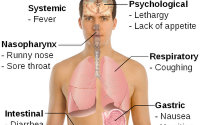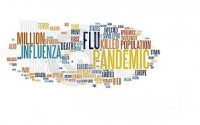Characteristic influenza viruses 2015-2016
Characteristic influenza viruses for the flu season 2015/2016 (Update)
 The main information in the USA about the characteristic influenza viruses is how they spread among the population, how the sickness goes and what are the consequences from the treatment. This information is given by the CDC. The researches that define the types of flu viruses during the flu season are connected to the current flu vaccines 2015-2016 that are Applied.
The main information in the USA about the characteristic influenza viruses is how they spread among the population, how the sickness goes and what are the consequences from the treatment. This information is given by the CDC. The researches that define the types of flu viruses during the flu season are connected to the current flu vaccines 2015-2016 that are Applied.
CDC characteristics influenza viruses through one or more tests, including genome sequencing, hemagglutination inhibition (HI) and/or neutralization assays. These test are from great importance for the determination of current flu viruses during the flu season. These test are helpful to determine if there is any kind of mutation in the flu virus, which can lead to serious problems. We all remember the case with the mutation of the virus strain H3N2 from the previous season, which stayed untouched by the selected vaccines. The result was very low efficiency from the vaccines for the period 2014-2015 and that led to lots of hospitalizations. Therefore the situation with the flu got very complicated and there were many cases of death.
CDC tests help determine whether the circulating influenza viruses, during the flu season, are relevant to the selected vaccines, which also determines if these vaccines will be efficient or not for the 2015-2016 flu season. From the begging of the 2014-2015 season and to this date, unfortunately, a portion of influenza A (H3N2) viruses do not yield sufficient hemagglutination titers for antigenic characterization by HI. For some of those viruses a genetic characterization is used to determine the strain they derive from. This way antigenic characteristic influenza viruses can be derived from this circulating viruses of this genetic group.
During the period 24-th May – 30-th September, american laboratories have characterized 337 groups of the virues. CDC say that 252 of them are the type A H3N2, 14 of them are type A (H1N1) pdm09 and 71 of them are virus type B.
Characterization of the groups of the viruses.
All 14 groups of the type A flu virus H1N1 pdm09 are defined as Antigenic and types like the Strain A (h1N1) pdm09 are included in the vaccines for the 2015-2016 season, not only in the USA but also in the entire Northern Hemisphere.
All of the 252 groups of the H3N2 virus type belong to the genetic groups, in which the majority of these viruses are antigenically characterized as similar to the flu strain A/Switzerland/9715293/2013, which is a component of the flu vaccines for the flu season 2015-2015 in the Northern Hemisphere.
Most of the characteristic influenza viruses grouped B viruses and more specifically 44 of the them are defined as type B/Yamagata/16/88. The Yamagata strain is antigenically identified as flu strain Type B/Puket/3073/2013, which is included in the bivalent flu vaccine for season 2015-2016.
The last 27 flu viruses of the B type are characterized as B/Victoria/02/87. This strain is genetically similar to the Strain type B/Brisbane/60-2008, which is included in the quadrivalent influenza vaccine for season 2015-2016.
After the 1-rst of October, american labs have gathered 12 more viruses, which the CDC characteristic influenza viruses as: one is virus type B, another is type A and the rest 10 viruses are type A (H3N2).
The 10 influenza A (H3N2) viruses, collected since October 1 2015, have been genetically sequenced and all viruses belonged to genetic groups for which the majority of the viruses antigenically characterized as being similar to A/Switzerland/9715293/2013. The influenza A (H3N2) is a component of the 2015-2016 Northern Hemisphere vaccine. Six Viruses ( one A (H1N1)pdm09, four A (H3N2) and on B/Yamagata-lineage) collected since October 1 2015, have been antigenically characteristic influenza viruses. All six were similar to the 2015-2016 norther Hemisphere influenza vaccine components.
To this day, there is only one case of pediatric death due to the flu during the flu season 2015-2016, according to the CDC. This incident happened in week 44 and was reported during week 45.

Two influenza-associated pediatric deaths were reported to CDC during week 5. One death was associated with an influenza A (H1N1)pdm09 virus and one death was associated with an influenza A virus for which no subtyping was performed. Both deaths occurred during week 4 (the week ending January 30, 2016).
A total of 11 influenza-associated pediatric deaths have been reported during the 2015-2016 season from Puerto Rico [1], Chicago [1], and seven states (California [2], Florida [2], Louisiana [1], Michigan [1], Nevada [1], Tennessee [1], and Washington [1]).
For now the ILI Net reports, that during week 45 only 1,6% of the patients who looked for medical care in doctors’ offices to off hospital care, had flu-like illnesses. These numbers are below the national base line and do not represent a problem. On the chart below you can see that for the moment, flu-like illnesses are on the same track as last year during the flu season. If this trend continues, this could mean that in the coming weeks we can expect a sharp rise in complaints of illness with flu-like symptoms.
In most states in the US, flu-like illness activity is normal or low. Only in South Carolina activity of influenza-like illness is moderate.
In most states, the flu spreads sporadically for now. Local outbreaks of influenza occur in several states – Hawaii, Iowa, New Hampshire, and Oregon. In Puerto Rico are monitored regional outbreaks of flu.
Although influenza activity is low at the moment, it is good to know some details. What to do if the flu strikes you down.
Treatment for influenza:
Many people think that if you get flu, you can treat it with antibiotics. Remember that the antibiotics are not effective in the treatment of influenza, unless the flu causes another disease. You can take painkillers for some flu symptoms, such as headache, muscle or joint pain. Should not be given pain medicines, that contain aspirin, to children under the age of 12. You can take medications to regulate the body temperature and to avoid fever. If you get sick with influenza you should follow these steps:
You should stay home and have plenty of rest. Make sure to drink lots of liquids.
Stay at home and avoid contact with other people. Keep warm and rest well. Take lots of liquids, but do not drink alcohol. If you are a smoker, stop the cigarets or at least try to reduce the smoking as much as you can. Try eating something, soups are recommended like naturally fight cold and flu . They are very easy to swallow and in the same time give you both liquids and nutrients, and they also are warm so you will get warm. If you live alone, tell somebody that you are sick. It’s good to have some one to look after and do the shopping for you.
If the flu symptoms do not lessen in the next 48 hours, it is best to look for a doctor. There are many herbal and homeopathic medications that can be taken for colds or flu, they can relive the symptoms.
This article isn’t written to replace medical care. The purpose of this article is to help you and inform you all about flu symptoms, how the flu is spread and which are the circulating viruses in the flu season 2015-2016. This way we hope to decrease the number of people getting sick with flu.






Flu vaccines are designed to protect against the main flu viruses that research suggests will be the most common during the upcoming season. Three kinds of flu viruses commonly circulate among people today: influenza A (H1N1) viruses, influenza A (H3N2) viruses, and influenza B viruses.
Thank you for share this helpful information. Your site is one from very good sites on the internet for information about flu and flu symptoms.
Expected in January and February, flu season reaches its peak. Let’s hope that viral vaccine 2015/2016 will do its rabota.Dano protect people from severe complications from influenza.